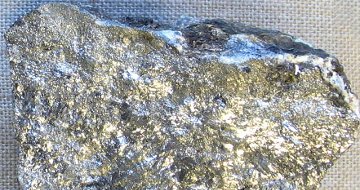
Antimony
Antimony General
| Name:Antimony | Symbol:Sb |
| Type:Metalloid, Nitrogen group | Atomic weight:121.75 |
| Density @ 293 K:6.684 g/cm3 | Atomic volume:18.22 cm3/mol |
|
Discovered:
The presence of antimony in historical artifacts indicates it was known to ancient civilizations. Combined with sulfur in stibnite (Sb2S3) it was used in Egyptian cosmetics four or five thousand years ago, as a black eyeliner.(1) |
|
Antimony States
| State (s, l, g):solid | |
| Melting point:903.94 K (630.79 °C) | Boiling point:1860 K (1587 °C) |
Antimony Energies
| Specific heat capacity: 0.21 J/gK | Heat of atomization: 262 kJ mol-1 |
| Heat of fusion:19.870 kJ mol-1 | Heat of vaporization : 67.97 kJ mol-1 |
| 1st ionization energy: 833.7 kJ mol-1 | 2nd ionization energy:1594.9 kJ mol-1 |
| 3rd ionization energy:2441.1 kJ mol-1 | Electron affinity:103 kJ mol-1 |
Antimony Oxidation & Electrons
| Shells:2,8,18,18,5 | Electron configuration: [Kr] 4d10 5s2 5p3 |
| Minimum oxidation number: -3 | Maximum oxidation number:5 |
| Min. common oxidation no.:0 | Max. common oxidation no.:5 |
| Electronegativity (Pauling Scale):2.05 | Polarizability volume:6.6 Å3 |
Antimony Appearance & Characteristics
| Structure: rhombohedral | Color: silvery white |
| Hardness:3.15 mohs | |
|
Harmful effects:
Like arsenic, which sits directly above it in the periodic table, the toxicity of antimony and its compounds varies according to the chemical state of the element. Many of the salts are carcinogenic. |
|
|
Characteristics:
Antimony is metalloid, so it has some metallic properties but not enough to be classified as a true metal. Physically, it behaves like sulfur while chemically it is more metallic. (1) In addition to the usual form of antimony, there are two allotropes: yellow crystalline and amorphous black. Uses: The major use of antimony is in lead alloys - mainly for use in batteries - adding hardness and smoothness of finish. The higher the proportion of antimony in the alloy, the harder and more brittle it will be. Alloys made with antimony expand on cooling, retaining the finer details of molds. Antimony alloys are therefore used in making typefaces for clear, sharp printing. |
|
Antimony Reactions
| Reaction with air:mild, w/ht, ⇒ Sb2Ox x=3-5 | Reaction with 6 M HCl:none |
| Reaction with 15 M HNO3:mild, ⇒ Sb2O5 | Reaction with 6 M NaOH:none |
Antimony Compounds
| Oxide(s):Sb2O3 Sb2O4 Sb2O5 | Chloride(s):SbCl3 SbCl5 |
| Hydride(s):SbH3 |
Antimony Radius
| Atomic radius:140 pm | Ionic radius (1+ ion):pm |
| Ionic radius (2+ ion):pm | Ionic radius (3+ ion):90 pm |
| Ionic radius (2- ion):pm | Ionic radius (1- ion):pm |
Antimony Conductivity
| Thermal conductivity:24.4 W m-1 K-1 | Electrical conductivity: 25.641 x 106 S m-1 |
Antimony Abundance & Isotopes
| Abundance earth's crust:0.2 parts per million by weight, 0.03 parts per million by moles | |
| Abundance solar system:950 parts per billion by weight, 10 parts per trillion by moles | |
| Cost, pure: $4.5 per 100g | |
| Cost, bulk:$0.44 per 100g | |
|
Source:
Most antimony is produced from stibnite (antimony sulfide, Sb2S3). It is also extracted as a byproduct of copper, gold and silver production. |
|
|
Isotopes:
31 whose half-lives are known, mass numbers 104 to 136. Of these, two are stable and found naturally in the percentages shown: 121Sb (57.36%) and 123Sb (42.64%). |
|
Antimony Other
|
Other:
References |
|
Prev: Tin Next: Tellurium |